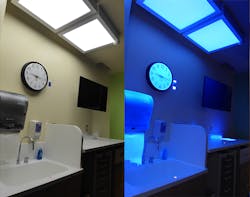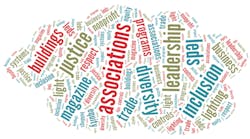The Lighting Research Center (LRC) at Rensselaer Polytechnic Institute has announced the results of research into the use of continuous disinfection technology based on ultraviolet (UV) LED emission in the UV-A band tested in a hospital setting. The research utilized solid-state lighting (SSL) luminaires from GE Current that were shown to destroy pathogens on surfaces after eight-hour exposure in a hospital intensive care unit. The tests also revealed, however, that the UV-A radiation also caused photodegrading effects in the rooms.
The research took place at the Memorial Beacon Children’s Hospital located in South Bend, IN. The focus was on elimination of what the health sector and the US Centers for Disease Control and Prevention (CDC) call healthcare-associated infections (HAI). Patients come into healthcare facilities looking for treatments for some malady, yet 1 in 25 contracts some HAI during a visit. A lighting-based treatment that could disinfect surfaces would presumably reduce the rate of HAIs.
We have previously written about the concepts of instantaneous- and continuous-disinfection using LED-based light. For example, Crystal IS detailed how its UV-C (100-to 280-nm band) LEDs can immediately kill pathogens disinfecting a flowing water supply. And in a hospital setting, UV-C energy could quickly disinfect surfaces. But UV-C must be used without humans present in a space such as sealed inside a water pump.
We have also written about the usage of UV-A (315-to 400-nm band) energy or short-wavelength energy in the violet or blue range to destroy pathogens over longer exposure times. Kenall Manufacturing was first to offer such violet technology — the product uses 405-nm emission just above the UV-A range — in its Indigo-Clean ambient lighting family and in fact won two LEDs Magazine Sapphire Awards for the technology that it licensed from the University of Strathclyde in Glasgow, Scotland. Vital Vio offers competing technology that it has licensed to Acuity Brands. And Hubbell Lighting has also licensed the Strathclyde technology.
The typical product mixes violet LEDs and white LEDs in a luminaire and only uses the violet LEDs during periods when a space is being disinfected. The mixed white and violet light is still usable for humans working in the space. The violet energy destroys pathogens over long exposure times, essentially via too much oxygen in cells.
Meanwhile, GE Current first discussed its UV-A-based disinfection technology at LightFair International (LFI) in 2018. The disinfection mechanism is similar to the violet energy. But the UV-A emission does not impact the quality of the light in the human visual range.
The LRC verified the safety of the UV-A approach, and the success in disinfecting surfaces. The results have been published in the academic journal Lighting Research & Technology. The LRC determined that exposure in the 350-to-380-nm range would be safe for humans over the exposure period required to kill target pathogens. The tests were focused on the sink and counter areas in patient rooms where HAIs would likely be an issue.
What the LRC describes as a hybrid luminaire was used in the test with separate UV-A and white LED channels. The white channel was controllable via a normal switch while the UV-A channel was programmatically controlled. The UV-A channel delivered energy of 3W/m2 at counter height for eight hours each day — safety regulations limit human exposure to such radiation to eight hours per day. The researchers also used shades to limit stray UV-A radiation and ensure protection of the infants in the hospital.
The tests yielded mixed results in part due to existing procedures used in effectively cleaning surfaces in the rooms. Still, there is evidence that the UV-A spectrum was effective at eliminating some pathogens. But the UV-A emission also damaged some fabrics in the rooms and has the potential to damage other equipment, necessitating further study.
“This lighting technology offers great promise in hospital applications,” said Jennifer Brons, director of design demonstrations at the LRC. “We are currently planning future demonstrations in another hospital unit with greater bioburden.”
“Reducing healthcare-associated infections is critically important,” said LRC professor Dr. Mark Rea. “Unfortunately, the prevalence of these infections is only expected to rise. The present findings should form the foundation for the next generation of this technology.”
*Updated Mar. 2, 2020 12:09 PM for Kenall emission wavelength information.





